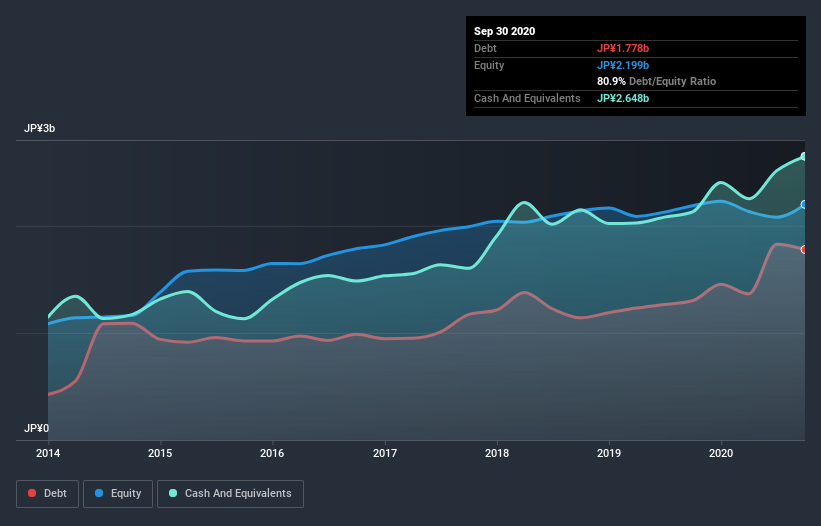Howard Marks put it nicely when he said that, rather than worrying about share price volatility, 'The possibility of permanent loss is the risk I worry about... and every practical investor I know worries about.' When we think about how risky a company is, we always like to look at its use of debt, since debt overload can lead to ruin. As with many other companies Striders Corporation (TYO:9816) makes use of debt. But the more important question is: how much risk is that debt creating?
Why Does Debt Bring Risk?
Debt and other liabilities become risky for a business when it cannot easily fulfill those obligations, either with free cash flow or by raising capital at an attractive price. If things get really bad, the lenders can take control of the business. However, a more common (but still painful) scenario is that it has to raise new equity capital at a low price, thus permanently diluting shareholders. Of course, plenty of companies use debt to fund growth, without any negative consequences. The first thing to do when considering how much debt a business uses is to look at its cash and debt together.
View our latest analysis for Striders
What Is Striders's Debt?
The image below, which you can click on for greater detail, shows that at September 2020 Striders had debt of JP¥1.78b, up from JP¥1.30b in one year. But on the other hand it also has JP¥2.65b in cash, leading to a JP¥870.0m net cash position.

How Healthy Is Striders's Balance Sheet?
We can see from the most recent balance sheet that Striders had liabilities of JP¥1.14b falling due within a year, and liabilities of JP¥1.98b due beyond that. On the other hand, it had cash of JP¥2.65b and JP¥260.0m worth of receivables due within a year. So its liabilities total JP¥211.0m more than the combination of its cash and short-term receivables.
Of course, Striders has a market capitalization of JP¥3.28b, so these liabilities are probably manageable. However, we do think it is worth keeping an eye on its balance sheet strength, as it may change over time. While it does have liabilities worth noting, Striders also has more cash than debt, so we're pretty confident it can manage its debt safely.
The modesty of its debt load may become crucial for Striders if management cannot prevent a repeat of the 38% cut to EBIT over the last year. When a company sees its earnings tank, it can sometimes find its relationships with its lenders turn sour. When analysing debt levels, the balance sheet is the obvious place to start. But you can't view debt in total isolation; since Striders will need earnings to service that debt. So if you're keen to discover more about its earnings, it might be worth checking out this graph of its long term earnings trend.
But our final consideration is also important, because a company cannot pay debt with paper profits; it needs cold hard cash. While Striders has net cash on its balance sheet, it's still worth taking a look at its ability to convert earnings before interest and tax (EBIT) to free cash flow, to help us understand how quickly it is building (or eroding) that cash balance. Happily for any shareholders, Striders actually produced more free cash flow than EBIT over the last three years. There's nothing better than incoming cash when it comes to staying in your lenders' good graces.
Summing up
We could understand if investors are concerned about Striders's liabilities, but we can be reassured by the fact it has has net cash of JP¥870.0m. The cherry on top was that in converted 142% of that EBIT to free cash flow, bringing in JP¥213m. So we are not troubled with Striders's debt use. There's no doubt that we learn most about debt from the balance sheet. However, not all investment risk resides within the balance sheet - far from it. Be aware that Striders is showing 5 warning signs in our investment analysis , and 2 of those are significant...
If you're interested in investing in businesses that can grow profits without the burden of debt, then check out this free list of growing businesses that have net cash on the balance sheet.
If you decide to trade Striders, use the lowest-cost* platform that is rated #1 Overall by Barron’s, Interactive Brokers. Trade stocks, options, futures, forex, bonds and funds on 135 markets, all from a single integrated account. Promoted
New: Manage All Your Stock Portfolios in One Place
We've created the ultimate portfolio companion for stock investors, and it's free.
• Connect an unlimited number of Portfolios and see your total in one currency
• Be alerted to new Warning Signs or Risks via email or mobile
• Track the Fair Value of your stocks
This article by Simply Wall St is general in nature. It does not constitute a recommendation to buy or sell any stock, and does not take account of your objectives, or your financial situation. We aim to bring you long-term focused analysis driven by fundamental data. Note that our analysis may not factor in the latest price-sensitive company announcements or qualitative material. Simply Wall St has no position in any stocks mentioned.
*Interactive Brokers Rated Lowest Cost Broker by StockBrokers.com Annual Online Review 2020
Have feedback on this article? Concerned about the content? Get in touch with us directly. Alternatively, email editorial-team@simplywallst.com.
About TSE:9816
Striders
Engages in the real estate, hotel, overseas, and other businesses primarily in Japan.
Excellent balance sheet second-rate dividend payer.
Market Insights
Community Narratives



